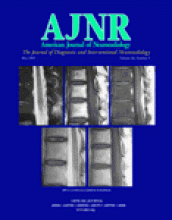Abstract
BACKGROUND AND PURPOSE: Occlusion of major cerebral arteries is the primary source of tissue damage in ischemic stroke and the target of thrombolytic therapy. We hypothesized that large infarcts in more proximal vascular occlusions correspond with substantially increased ischemic lesions shown on initial apparent diffusion coefficient (ADC) maps.
METHODS: Initial ADC lesions in 120 patients with acute ischemic stroke were analyzed within 6 hours of stroke onset. Patients were categorized on the basis of vascular occlusion, as shown on MR angiography. Lesion volumes were determined by using manual delineation (ADCman) and a threshold method for ADC values (<550 × 10−9 mm2/s−1, ADC<550). Infarct volumes were analyzed by using T2-weighted (n = 109) or CT (n = 11) images obtained on days 5–8.
RESULTS: Median lesion volumes for ADC<550, ADCman, and infarcts, respectively, were as follows: proximal internal carotid artery (ICA)/middle cerebral artery (MCA) occlusions, 10, 23, and 32 cm3; carotid-T occlusions, 11, 37, and 138 cm3; MCA trunk occlusions, 11, 27, and 44 cm3); and MCA branch occlusions 8, 27, and 21 cm3. Initial ADC lesion volumes were different only between the carotid T and the MCA branch (P < .05). On days 5–8, infarct volumes decreased from proximal to distal sites (P < .05), with the exception of MCA trunk versus proximal ICA/MCA occlusions. Recanalization rate in carotid-T occlusion was significantly lower than those of all other occlusion types.
CONCLUSION: Initial ADC lesions can be small, even in patients with proximal vascular occlusions. These patients develop considerably large infarctions, suggesting a high potential for infarct growth. This growth might be averted with improved early recanalization of proximal vascular occlusions.
- Copyright © American Society of Neuroradiology












